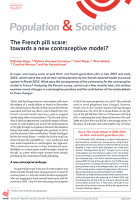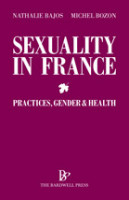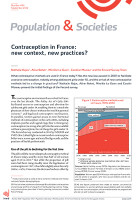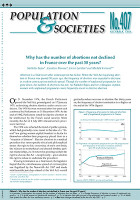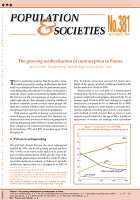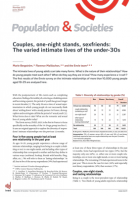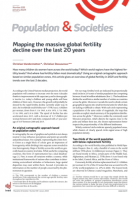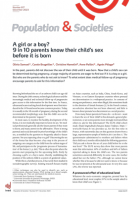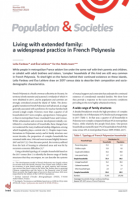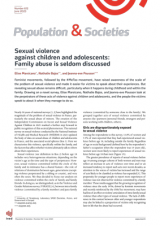
Sexual violence against children and adolescents: Family abuse is seldom discussed
Population and Societies
n° 612, June 2023
https://doi.org/10.3917/popsoc.612.0001
University of Strasbourg, Laboratory SAGE (Societies, Actors, and Government in Europe)
INSERM-EHESS-IRIS
INSERM-IRIS
Sexual violence in childhood and adolescence is an extremely widespread phenomenon in France, especially for girls. It affects people from all social backgrounds. Boys are less likely to experience violence and less likely to talk about it. Girls mostly experience sexual abuse from family members or friends. Most abusers are men. One in 2 women who suffered sexual abuse as a child or adolescent, and 1 in 3 men, have spoken to someone about it. They most often confide only in family members, particularly their parents, and close intimates.
sexual violence, children, adolescents, minors, family, incest, assault, speech, France
Table of contents
- Appendix A References
1.
Feminist movements, followed by the #MeToo movement, have raised awareness of the scale of the problem of sexual violence and made it easier for victims to speak about their experiences. But revealing sexual abuse remains difficult, particularly when it happens during childhood and within the family. Drawing on a novel survey, Elise Marsicano, Nathalie Bajos, and Jeanna-eve Pousson look at the perpetrators of these acts of violence against children and adolescents, and the people the victims speak to about it when they manage to do so.
Nearly 30 years of national surveys [1, 2] have highlighted the magnitude of the problem of sexual violence in France, particularly the sexual abuse of minors. The creation of the Independent Commission on Incest and Sexual Violence Against Children in 2021 marked a further step forward in public recognition of this societal phenomenon. The national survey on sexual violence conducted by the National Institute of Health and Medical Research (INSERM) in 2021 updated the div of data on sexual abuse of children and adolescents in France, and the associated social spheres (Box 1). Here we characterize this violence, specifically within the family, and the factors that affect whether victims ultimately talk to others about their experiences.
Sexual violence (see definition in Box 2) before age 18 includes very heterogeneous situations, depending on the victim’s age at the time and the type of perpetrator. However, sexual violence committed within the circle of the family and its intimates has a shared feature—the role of relations of domination between ages, generations (excepting violence perpetrated by a sibling or cousin), and very often the sexes. We thus decided to focus our analysis on violence committed within the circle of family and family friends. In doing so, we distinguished, as in the Violence and Gender Relations survey (VIRAGE) [4], between intra-family violence (committed by a family member) and para-family violence (committed by someone close to the family). We grouped together acts of sexual violence committed by anyone else (partners/personal friends, strangers and persons working with children, others).
1.1. Girls are disproportionately exposed to sexual violence
Among the respondents to this survey, 13.0% of women and 5.5% of men reported that they had experienced sexual violence before age 18, including outside the family. Regardless of age or social background (defined here by the respondent’s father’s occupation when the respondent was 15 years old), women were more likely to report experiences of sexual violence before age 18 than men (Figure 1A).
The greater prevalence of reports of sexual violence before age 18 among younger cohorts of both women and men may reflect an increase in acts of violence over time and/or an increased tendency to report such acts over recent decades, as attention to the voices of victims has increased and the range of acts likely to be classified as violence has expanded [5]. This propensity for younger people to report more experiences of violence was not observed for violence committed by a family member. These results suggest that the growing recognition of violence since the early 1970s, driven by feminist movements and recently reinforced by the #MeToo movement, may have had less of an effect on victims’ articulation of intra-family sexual violence than other types of sexual violence. The lack of difference in this context between older and younger respondents may also be linked to a proportion of victims only recognizing later in life that the abuse had occurred.
The survey confirms the prevalence of sexual violence against minors regardless of social class. For example, 13.4% of women whose father was in a higher-level occupation when they were 15 years old reported having experienced such violence; the corresponding proportion among those whose father was a manual worker was 12.2% (5.8% and 5.1% for men).
Women and men whose father either did not have stable employment or was deceased or unknown were more likely to report sexual violence than others (Figure 1B). These results illustrate the important influence of the individual’s life context on their likelihood of experiencing sexual violence. Multiple hypotheses may account for this result. Fathers without stable employment, unable to fulfil their social role as resource providers, may experience this situation as a loss of authority and in some cases express it through violent behaviour. The absence of a father may also lessen the protection of some children and adolescents against abuse by other adults.
1.2. Sexual violence in and around the family is very widespread
The family is the social sphere where women report the most sexual violence. In total, 4.6% of the women surveyed and 1.2% of the men surveyed reported experiencing incestuous violence before the age of 18 (Online Appendix Table A.11). Such abuse is also often committed by family friends: 2.2% of women and 0.7% of men reported having been abused by someone close to the family. In combination, this means that 6.8% of women and 1.9% of men reported either intra-family or para-family violence. Other cases, which include a range of different types of situations, were reported by 6.1% of women and 3.7% of men. The most common are those committed by a partner/personal friend (2.7% and 0.8%), a stranger in a public place (1.7% and 0.9%), or a person working with children (0.7% and 1.3%). Among all respondents who reported experiences of sexual violence before they reached the age of 18, 35.7% of women indicated that the perpetrator was a family member versus 21.6% of men. In 96.5% of cases, the family member committing such abuse against a girl was a man; in cases where the victim was a boy, the figure is 89.7% (Online Appendix Table A.2). More specifically, 1 in 3 cases of intra-family violence against women (32.7%) was committed by their father or stepfather, followed by an uncle (17.9%), cousin (14.4%), or brother (14.1%). For men, the most common categories of abusers were a brother (21.8%), followed by a father or stepfather (20.7%), cousin (17.8%), or uncle (16.7%).
1.3. Sexual violence often begins at a very young age and is repeated over time
Nearly 40% of the sexual violence before age 18 reported in the survey happened before age 11 (Table 1). On average, those who reported having been sexually abused by a family member or family friend were younger at the time than other respondents: more than half of women who reported sexual abuse by a family member or family friend were younger than 11 when the first act of sexual violence occurred. Men’s responses showed the same tendencies.
Violence committed by a family member, and to a lesser extent by a family friend, is more often repeated over the course of multiple years compared to other situations, where it is more often a one-off event, particularly for women. Finally, among men who reported experiencing sexual violence, the abuse was more likely to be rape than among women. Rape is more common than sexual touching when the abuser is a family member or family friend.
1.4. Speaking about sexual abuse in childhood remains difficult
More than half of women (51.4%) and 39.0% of men who reported an experience of sexual violence indicated that they had spoken about it with someone else (Online Appendix Table A.3). The younger the respondent, the more likely they were to have spoken to someone about the abuse. This was the case of 59.6% of women and 52.2% of men aged 18–24 versus 42.4% of women and 25.0% of men over 60. Over the generations, then, confiding in others about experiences of abuse has become more common. Among those who reported that they had never spoken about it, some may have tried to do so [6] or to draw attention to a situation that they perceived as abnormal but have been unsuccessful in eliciting a response from those around them. These difficulties with speaking about sexual violence are doubtless greater in older generations, who were abused in a time that was less favourable to the articulation of these types of acts.
No significant differences were found in the likelihood of having spoken about sexual abuse committed by a man or a woman, or between victims who experienced an act of sexual violence for the first time at different ages (Online Appendix Table A.3). While women are more likely than men to have spoken about sexual touching (48.9% vs. 32.1%), for rape the likelihood is similar (55.1% and 46.7%). These results may partly be due to an effect of men’s socialization into the use of violence, which may make them less inclined to recognize touching as sexual assault and to speak to someone else about it.
The results also show that the longer the period of sexual violence, the more likely the victim is to have spoken about it. Multivariate analyses confirmed these results (Online Appendix Table A.3). The factors influencing the propensity to speak about sexual violence experienced in childhood and adolescence thus seem to be the generational/historical context of the abuse (as reflected by age at survey), the immediate context (notably the type of perpetrator for women, who were more likely to speak about abuse committed by a family member), and the duration of the period of abuse.
1.5. Sexual abuse is not often mentioned to anyone but close relations
Persons who experienced sexual abuse in childhood and went on to talk about it most often did so with someone close to them. Over a fifth of women (21.1%) and 12.9% of men spoke about it to their parents, respectively 17.5% and 12.5% to their partner, and 17.2% and 10.3% to a friend (Figure 2). Under 1 in 7 (13.8% of women and 11.7% of men) mentioned it to a healthcare professional. While women are generally more likely to speak about abuse than men, this is not the case when it comes to confiding in representatives of the police or the justice system, where the proportions for women and men are nearly identical (7.9% of women and 7.4% of men). This lack of a difference between the sexes may reflect women’s greater distrust of institutions that they often do not perceive as appropriately responsive to their reports and experiences.
Only 8.4% of women and 8.3% of men abused by a family member told both their parents and at least one healthcare, police, or legal professional. These results are consistent with the results of Dussy [6], showing that victims of incest are often discouraged from talking about it to people outside the family circle. They are thus widely prevented from seeking professional care, even though such care is essential given the consequences of this type of violence for the victims. These results show that while it is important to help individuals both speak about sexual abuse and listen to others speaking about it, facilitating victims’ access to persons outside their family circle is also important to improve access to care. Of particular importance is the role of educational professionals, given that schools are the only context of socialization shared by all children.
1.5.1. Box 1. A survey on sexual violence in France
This article is based on a survey requested and funded by the Independent Commission on Sexual Abuse in the Catholic Church (CIASE), which was carried out between 25 November 2020 and 28 January 2021. The survey was conducted independently by an INSERM research team, and investigated all sexual violence experienced before age 18 in any social sphere (family, church, school, etc.). The survey was anonymous: no identifying personal information on respondents was collected. It was validated by INSERM’s ethics committee. For financial reasons and due to measures related to the COVID-19 pandemic, it was carried out entirely online.
In total, 243,601 panellists aged 18 or over who were registered with a polling company were selected semi-randomly (based on age, socio-occupational category, region, and number of previous requests to participate in other surveys by the polling company) and invited to complete the questionnaire. The respondents were compensated with vouchers. Among those who received the initial invitation, nearly 20% clicked on the link before learning the topic of the survey. Among the 28,555 eligible respondents, 180 did not choose to fill in the questionnaire, and 69 stopped before reaching the end. A further 295 questionnaires were excluded from the analysis (duplicate or unusable). Thus, 28,011 questionnaires were included in the analysis. The sample was adjusted for the respondents’ age, gender, region of residence, size of the urban area, and occupation (for a detailed presentation of the methodology and limitations of the survey, see [3]). The resulting weighted estimators can thus be considered representative of the experiences of the current population of metropolitan France. As in any survey on violence, both under-reporting and biases in reporting are likely.
1.5.1. Box 2. Classification of abuse and indicators of speech about abuse
After answering a few sociodemographic questions, participants read that ‘In this survey, sexual abuse is defined as when one person forces another to engage in a sexual act. This includes rape, attempted rape, and sexual touching without consent.’ Those who reported that they had experienced abuse were then asked to indicate which acts they had been subjected to. These were divided into sexual touching, on the one hand, and fellatio, cunnilingus, penetration, or attempted penetration, which fall under the legal category of rape, on the other hand. For our analysis, the other categories (sexual exposure, speech, messages, or photos), as well as respondents who chose not to answer the question (375), were not classified as victims of sexual violence.
Two indicators of speech about sexual violence were chosen for analysis:
• Revealing an experience of violence as part of this survey
• Reporting having spoken about it to another person
Appendix A References
-
[1] Debauche A., 2011, Viol et rapports de genre: émergence, enregistrements et contestations d’un crime contre la personne [Doctoral thesis, Institut d’études politiques, Paris].
-
[2] Jaspard M. and the ENVEFF team, 2001, Nommer et compter les violences envers les femmes: une première enquête nationale en France, Population & Sociétés, 364.
-
[3] Bajos N., Ancian J., Tricou J., Valendru A., Pousson J.-e., 2022, Child sexual abuse in the Roman Catholic Church in France: Prevalence and comparison with other social spheres, Journal of Interpersonal Violence, 38(7–8). https://doi.org/10.1177/08862605221124263
-
[4] Charruault A., Grunvald S., Scodellaro C., 2020, Les violences sur mineur.e.s dans la famille et son entourage, in Brown E., Debauche A., Hamel C., Mazuy M. (eds.), Violences et rapports de genre. Enquête sur les violences de genre en France (149–181), INED.
-
[5] Bajos N., Bozon M., 2008, Les violences sexuelles en France: quand la parole se libère, Population & Sociétés, 445.
-
[6] Dussy D., 2013, Le berceau des dominations. Anthropologie de l’inceste, Vol. 1, Éditions La discussion.
The Online Appendix is available at: https://doi.org/10.34847/nkl.212cr1t4
Sexual violence in childhood and adolescence is an extremely widespread phenomenon in France, especially for girls. It affects people from all social backgrounds. Boys are less likely to experience violence and less likely to talk about it. Girls mostly experience sexual abuse from family members or friends. Most abusers are men. One in 2 women who suffered sexual abuse as a child or adolescent, and 1 in 3 men, have spoken to someone about it. They most often confide only in family members, particularly their parents, and close intimates.
Elise Marsicano
Nathalie Bajos
Jeanna-eve Pousson
Cite the article
Elise Marsicano, Nathalie Bajos, and Jeanna-eve Pousson, 2023, Sexual violence against children and adolescents: Family abuse is seldom discussed, Population and Societies, no. 612
 This document may be reproduced free of charge on paper or online using our Creative Commons licence.
This document may be reproduced free of charge on paper or online using our Creative Commons licence.

